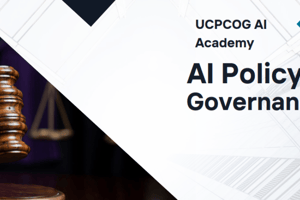Podcast
Questions and Answers
Which of the following is a key aim of exploring insurance mechanisms in the context of AI governance?
Which of the following is a key aim of exploring insurance mechanisms in the context of AI governance?
- To primarily focus on stifling innovation to prevent any risks.
- To replace traditional regulatory approaches entirely.
- To solely benefit insurance companies by expanding their market reach.
- To financially incentivize AI safety and compensate for potential harms. (correct)
How can insurance mechanisms assist Global South countries in AI governance?
How can insurance mechanisms assist Global South countries in AI governance?
- By imposing Western regulatory standards, irrespective of local challenges.
- By enabling agency in the global AI governance landscape while protecting their populations from potential harms. (correct)
- By providing direct financial aid to accelerate AI development, regardless of safety concerns.
- By offering a one-size-fits-all insurance model suitable for all economic contexts.
Insurance frameworks aim to replace the need for direct regulation of AI systems.
Insurance frameworks aim to replace the need for direct regulation of AI systems.
False (B)
What role does risk assessment play in the context of AI insurance?
What role does risk assessment play in the context of AI insurance?
According to DLA Piper's Global AI Governance Report, a significant majority of organizations have a defined AI ______.
According to DLA Piper's Global AI Governance Report, a significant majority of organizations have a defined AI ______.
What is the primary challenge associated with the lack of transparency in complex AI models like LLMs?
What is the primary challenge associated with the lack of transparency in complex AI models like LLMs?
AI systems are immune to propagating societal biases due to their reliance on data-driven algorithms.
AI systems are immune to propagating societal biases due to their reliance on data-driven algorithms.
Which measure is recommended for companies adopting AI to mitigate severe liability risks?
Which measure is recommended for companies adopting AI to mitigate severe liability risks?
What factor complicates the accurate assessment and pricing of AI risks for insurance companies?
What factor complicates the accurate assessment and pricing of AI risks for insurance companies?
Insurers can incentivize responsible AI development by offering lower ______ to companies that implement robust safety measures.
Insurers can incentivize responsible AI development by offering lower ______ to companies that implement robust safety measures.
AI technologies are exclusively used to enhance customer service capabilities in the insurance sector, with limited impact on other areas.
AI technologies are exclusively used to enhance customer service capabilities in the insurance sector, with limited impact on other areas.
Which of the following is a critical element for insurers to mitigate AI risks effectively?
Which of the following is a critical element for insurers to mitigate AI risks effectively?
Which document focuses on how insurers will govern the development/acquisition and use of certain AI technologies?
Which document focuses on how insurers will govern the development/acquisition and use of certain AI technologies?
The NIST AI RMF addresses ______ considerations in the design, development, use, and evaluation of AI products, services and systems.
The NIST AI RMF addresses ______ considerations in the design, development, use, and evaluation of AI products, services and systems.
Implementing AI in insurance guarantees improved customer satisfaction and reduced operational costs without introducing new risks.
Implementing AI in insurance guarantees improved customer satisfaction and reduced operational costs without introducing new risks.
What is a key element to successful AI implementation within an insurance organization?
What is a key element to successful AI implementation within an insurance organization?
Which method will be employed for AI Insurance Governance research?
Which method will be employed for AI Insurance Governance research?
Analysis will only be made from a Western perspective.
Analysis will only be made from a Western perspective.
List insurance examples that are applicable or are already used with Artificial intelligence.
List insurance examples that are applicable or are already used with Artificial intelligence.
Match each risk with its appropriate mitigation:
Match each risk with its appropriate mitigation:
What does Data Mkononi provide?
What does Data Mkononi provide?
What does the EU’s AI Directive state?
What does the EU’s AI Directive state?
AI insurance is one singular risk.
AI insurance is one singular risk.
Why has the legislator in Italy introduced mandatory insurance?
Why has the legislator in Italy introduced mandatory insurance?
What is changing about insurance due to AI?
What is changing about insurance due to AI?
New insurance products will not cover risks deemed uninsurable.
New insurance products will not cover risks deemed uninsurable.
Integration and implementation of ______ is a potential AI risk.
Integration and implementation of ______ is a potential AI risk.
What is the risk if sensitive data is used to train third party models?
What is the risk if sensitive data is used to train third party models?
AI integration will have no biased outcomes regarding insurance claims.
AI integration will have no biased outcomes regarding insurance claims.
How do insurers use AI to reduce the opportunity for fraud?
How do insurers use AI to reduce the opportunity for fraud?
Which item is an example assessment area when evaluating AI systems?
Which item is an example assessment area when evaluating AI systems?
Insurance firms have no need to stream line operations.
Insurance firms have no need to stream line operations.
What can insurance companies use to help operate securely, compliantly and for high perfroming AI systems?
What can insurance companies use to help operate securely, compliantly and for high perfroming AI systems?
What risk area will insurance and reinsurance target?
What risk area will insurance and reinsurance target?
AI governance is well know in AI Governance.
AI governance is well know in AI Governance.
______ will drive insurance frameworks by insuring safety.
______ will drive insurance frameworks by insuring safety.
What factors should be taken into consideration when analysing risk?
What factors should be taken into consideration when analysing risk?
Flashcards
Insurance as Governance tool
Insurance as Governance tool
Leveraging insurance mechanisms mitigates catastrophic AI risks and incentivizes AI safety.
Effective Insurance Systems
Effective Insurance Systems
Distribute, manage, and mitigate AI risks while creating financial incentives for responsible AI development.
Insurance Frameworks
Insurance Frameworks
Insurance frameworks quantify potential harms, incentivizing safety to bridge technical AI safety research and governance.
Insurance vs. Direct Regulation
Insurance vs. Direct Regulation
Signup and view all the flashcards
Comprehensive Framework
Comprehensive Framework
Signup and view all the flashcards
Equity in AI Governance
Equity in AI Governance
Signup and view all the flashcards
Institutional Memory
Institutional Memory
Signup and view all the flashcards
International Coordination
International Coordination
Signup and view all the flashcards
Developing Insurance Frameworks
Developing Insurance Frameworks
Signup and view all the flashcards
Compulsory Insurance Cover
Compulsory Insurance Cover
Signup and view all the flashcards
Financial Translation
Financial Translation
Signup and view all the flashcards
Market-Based Approach
Market-Based Approach
Signup and view all the flashcards
AI's Catastrophic Potential
AI's Catastrophic Potential
Signup and view all the flashcards
Key Research Questions
Key Research Questions
Signup and view all the flashcards
Risk Mitigation Strategies
Risk Mitigation Strategies
Signup and view all the flashcards
Insurance Mechanisms
Insurance Mechanisms
Signup and view all the flashcards
Research Approach
Research Approach
Signup and view all the flashcards
Interdisciplinary Approach
Interdisciplinary Approach
Signup and view all the flashcards
Data Bias
Data Bias
Signup and view all the flashcards
Areas for Research
Areas for Research
Signup and view all the flashcards
AI Impact on Insurance
AI Impact on Insurance
Signup and view all the flashcards
Benefits of AI in Insurance
Benefits of AI in Insurance
Signup and view all the flashcards
The AI Risks for Insurance Companies
The AI Risks for Insurance Companies
Signup and view all the flashcards
AI in Financial Services
AI in Financial Services
Signup and view all the flashcards
Lack of Transparency
Lack of Transparency
Signup and view all the flashcards
The AI Risk Mitigation
The AI Risk Mitigation
Signup and view all the flashcards
Al Propagates Biases
Al Propagates Biases
Signup and view all the flashcards
Al Use Expands Services
Al Use Expands Services
Signup and view all the flashcards
AI Adoption Benefits
AI Adoption Benefits
Signup and view all the flashcards
The AI Risk Challenge
The AI Risk Challenge
Signup and view all the flashcards
Data Analysis
Data Analysis
Signup and view all the flashcards
Collaboration with AI Experts
Collaboration with AI Experts
Signup and view all the flashcards
NIST Framework
NIST Framework
Signup and view all the flashcards
Study Notes
Leveraging Insurance Mechanisms for AI Governance
- Insurance mechanisms are a governance tool to mitigate catastrophic AI risks.
- AI safety is financially incentivized through insurance.
- Policymakers, especially in Global South countries, are guided to adopt risk-based insurance frameworks.
- Insurance frameworks provide compensation for potential harms.
- These frameworks prevent existential threats posed by highly capable AI systems.
Designing Effective Insurance Systems for AI
- Insurance systems need design that can distributes manages, and mitigates catastrophic risks from advanced AI.
- Financial incentives are created for responsible AI development and deployment.
- Insurance mechanisms are designed to effectively distribute, quantify, and mitigate catastrophic AI risks.
- The design process includes providing compensation frameworks for any potential harms.
Junior Research Fellow at ILINA
- ILINA (the ideal place to do the research) promotes effective AI governance
- The program provides a unique opportunity to refine research and contribute to the discourse on AI safety
The Importance of Exploring AI Insurance Mechanisms
- Exploring insurance mechanisms provides governance tools used for AI risk management.
- The exploration examines the intersection of financial incentives, regulatory frameworks, and catastrophic risk mitigation.
- Insurance frameworks helps translates abstract AI risks into concrete financial terms for policy makers, developers, and investors.
- Quantifying harms and creating financial incentives helps bridges the gap between AI safety.
- Insurance approaches complements direct regulation offering market based solutions.
- Flexible and graduated incentives in insurance help adapt to emerging risks and the rapidly evolving AI sector in general.
- The research focuses on equity, as Global South countries risk exclusion from AI development and governance frameworks.
- Insurance mechanisms can create institutional memory and knowledge repositories about AI risks by collecting data.
- It provides a pathway for international coordination
- Lack of global consensus on AI governance means insurance is an important tool for safety standards.
Insurance for Catastrophic AI Risks
- The role of the insurance industry is a key area of AI governance.
- This is important for mitigating catastrophic AI risks involving existing legal standards, regulatory frameworks, and financial risk mitigation strategies.
- Legal and regulatory frameworks incentivize AI developers, and prioritize safety.
- Insurance based risk management can be integrated into AI policies in global south countries
- The goal is to help promote AI governance by utilizing insurance mechanisms to prevent catastrophic risks.
- Financial incentives and regulations encourage responsible AI development.
- Insurance instruments mitigate both immediate harms and cater for potentially catastrophic risks.
- Focus shifts to offer concrete paths built on parametric triggers, smart self-executing contracts etc.
AI and Insurance Links
- Artificial intelligence (AI) is rapidly advancing introducing risks which must be proactively addressed.
- Mitigation strategies need to be adapted to ensure AI safety.
Key Research Questions
- How can insurance policies discourage the development and deployment of unsafe AI systems?
- How can legal and regulatory frameworks incentivize AI developers to prioritize safety through risk-based insurance models?
- How can Global South countries influence global AI governance by integrating insurance-based risk management into their AI policies?
- What lessons can be drawn from other industries to shape AI governance?
AI Insurance Mechanisms
- Mitigating AI catastrophic risks includes covering AI systems
- The risks are unprecedented
- Jesse Thaiya's work provides insurance mechanisms
- Insurance can create financial incentives for responsible AI development
AI and Insurance Qualifications
- A background in law, human rights, and data protection combines with experience in AI governance and policy advocacy.
- The combination helps the ability to explore how financial and regulatory mechanisms safeguard against AI-driven risks.
- Experience in data privacy, complex dispute resolution, and governance structures shapes AI policy.
The ILINA program
- The intersection of governance, financial liability, and AI safety is underexplored, this gap is bridged by ILINA.
- ILINA provides interdisciplinary AI governance approaches, economics, risk management, law, and technical AI safety.
- ILINA has novel research ideas offering different approaches, from AI safety audits to global AI insurance standards.
AI and Insurance Risks
- Concerns exist around ethical oversight, societal biases, data privacy, cybersecurity, and intellectual property.
- Transparency is lacking specifically in complex LLMs.
- Bias can result in discriminatory outcomes, data privacy, and cybersecurity.
- There are also legal issues around intellectual property regarding training AI algorithms on datasets.
Insurance Solutions
- Companies adopting AI are exposed to liability towards customers, partners, and stakeholders.
- Companies can mitigate risks with internal policies, contractual safeguards, technical measures like encryption, security audits and regular employee training.
- AI risks can be addressed through existing insurance or new policies which can be used to determine next steps
Insurability of AI Risks
- Companies assess the risks stemming from AI systems.
- Risks can be handled through brokers and existing, or new, insurance coverage. Existing policies may cover AI risks, but gaps exist.
- Risk assessment is the basis of insurance, requiring definitive, accidental loss at a specific time, from specific causes.
- The losses must be predictable, and have affordable premiums.
AI Risk assessment
- Risk assessments are vital for underwriters and insureds.
- Underwriters can exclude or limit specific risks, and insureds can shape coverage.
- Accurate AI liability risk assessment is a new frontier, due to rapidly changing risks.
- Insurance policies provide solutions adapting to AI challenges, such as specific exclusions, consistent deductibles, and tailored coverage limits
- Some currently covered risks may become uninsurable or require higher premiums.
EU Regulations on AI and Insurance
- The EU may provide precise indications in the AI Directive and the AI Act, with imposition of compulsory insurance cover.
- The AI Directive, for instance, aims at harmonizing the liability regime for damages caused by AI systems
- There is no specific definition for who the insurance obligation should apply to
The use of AI by Insurance Companies
- Implementation of risk assessment is needed.
- Use of AI will allow the expansion of various sectors, such as, cybersecurity insurance, blockchain integration, and climate risk assessment
- Legislators have introduced mandatory insurance against catastrophic events.
- AI must be able to assess and promptly adapt to cater for the demand of insureds
AI Insurtech
- Insureds can notify claims, providing photos and requesting immediate assistance for repairs, thanks to AI.
- Software is created providing summaries judicial pleadings and quick analysis spedding up management for claims handlers
Key Takeaways
- Understanding AI risk is important
- More AI could imply more risks to be insured
- More insurance products need to cover risks that were previously considered uninsurable.
- AI will improve differentiation of risks, tailor-made insurance solutions, fraud detection, affordable premiums, claims handling and implementation.
What methodology is to be used
- A mixed-methods approach is required, comparative analysis, expert interviews, economic modeling etc..
- Existing catastrophic risk is important
- Transferable models and implementation barriers is required for AI governance.
- Implement Global South solutions which address resource constraints
- The correct risk profiles are needed
- Financial incentives and safety protocols must be adhered to
Studying That Suits You
Use AI to generate personalized quizzes and flashcards to suit your learning preferences.




